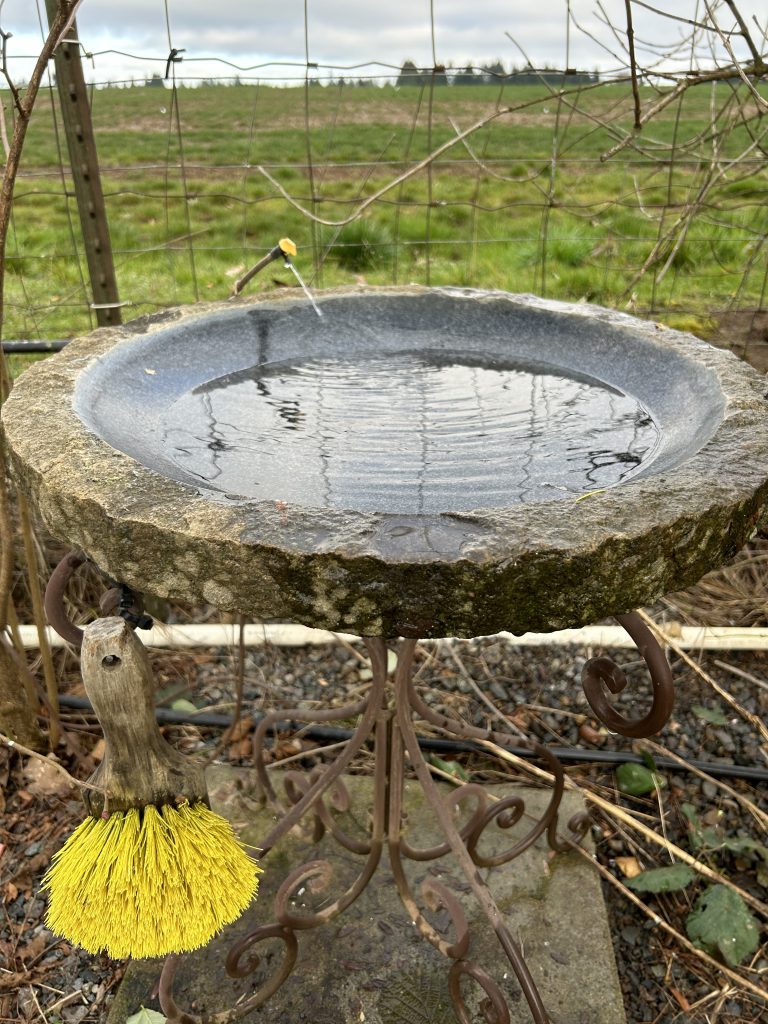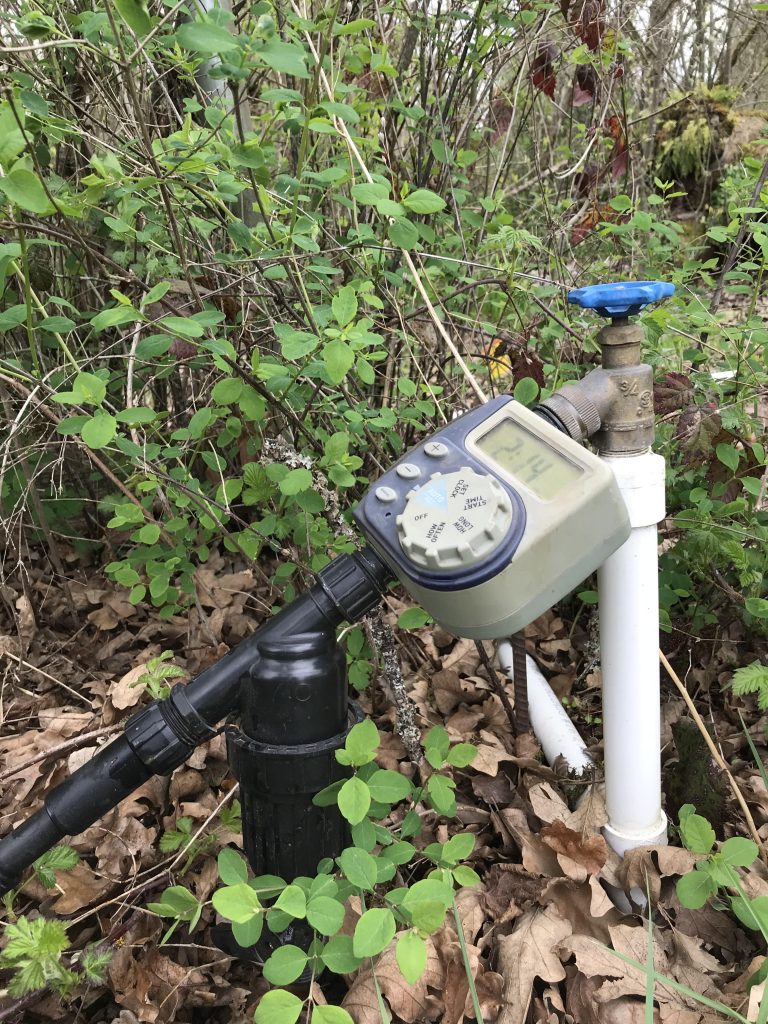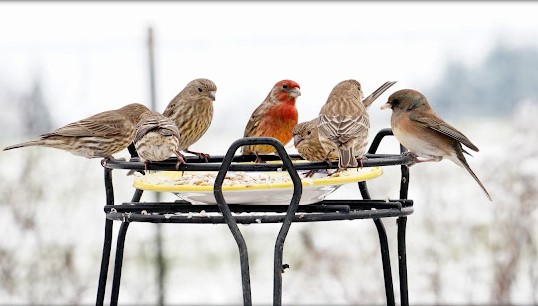Birds, mammals, and insects need water to drink. In addition, birds rely on bathing for feather cleansing and preening them back into place, where they repel water, help retain warmth, and provide an aerodynamic body covering. As with people, water aids several physiological processes that maintain health and bodily functions in birds. They can synthesize water metabolically from their diets, but seed eaters especially need additional fluid water.
This article is geared towards residential properties that don’t include perennial ponds, streams, wetlands, or other natural water sources. I focus on establishing some basic best practices regarding whatever means you select to provide water for local wildlife, and to share an approach that has worked very well on our rural property. Designs for both portable and permanent water features are readily available online and in books. I’ve included several links to get you started. As you review designs, always ask yourself “How will I provide fresh water, how will I keep it clean?”

The Willamette Valley is plenty wet in winter but arid in summer. When the seasonal stream that runs across the front of our property goes dry in April, the birds, bees, and assorted mammals that live here have a dry five or six months ahead of them. At the other end of the calendar, though our winters are well known for rain, snow cover and hard freezes make water scarce in our yards for short periods every year. Water is important throughout the year. What to do?
You can make a difference for those animals lucky enough to visit your yard. Options include integrating permanent water features into your landscape or using portable features that give you flexibility in their use. Or both. Features can be as formal or ad hoc as you want but they should all share some best practices in design and application:
- Keep it Clean. Sanitation is your priority; birds and mammals are not housebroken. They poop in the water, walk in the water with muddy feet, and are generally messy. Water in trays, bird baths, or other containers needs to be flushed and brushed out every few days. Water left unchanged too long will accumulate dead leaves and trash, and, with the nutrients from poop and decaying organic matter, will become green with algae and a health hazard to the creatures you are trying to aid. Always have a way to clean water containers with a stiff brush and hose them out, whether you do it where they sit or take them to to the water supply. We keep a hose with a jet spray nozzle nearby and a stiff brush at the bird bath.

- Keep it Safe. Birds come in all sizes from quail chicks on the ground to crows anywhere. Consequently, your water feature must provide shallow water with easy escape; no straight-sided deep pans. A couple of inches is deep enough. When we moved to the country 13 years ago we provided water in three-inch deep straight-sided trays. When a quail chick drowned we learned quickly to assure that we were not creating traps.
- Consider Level of Placement. Some birds live mostly on the ground; others are more attuned to being above ground level where they can watch for danger. If you only have traditional raised bird baths you will not serve quail and other birds with precocial chicks well. If you have only ground level stations you will serve many, but in open settings most other birds will prefer to be elevated, as in a bird bath.

- Consider Nearby Cover. Portable water stations that you can try out in various settings are useful for determining where to set up. We have summer water in our riparian brush and tree corridor, at the edge where the riparian brush gives way to lawn, in the open near some brush piles, and, in out two small meadows, and all year along the back fence between us and a farm field. Escape cover and staging bushes nearby can be important. And, we often see juvenile robins and towhees feeding around water features where bathing birds and raccoons splash out water that keeps the immediate soil damp enough to attract invertebrates. Over the years we have come to target several locations that have proven to be used well.
- Refresh Regularly. Drip irrigation is a dandy way to serve portable water basins. Ours are set up on timers to deliver ten minutes of fresh water to each site once a day. Permanent installations can be plumbed in the same manner or with permanent subsurface supply lines.

- Mammals Need Water Too. Anything that serves birds on the ground will also be used by mammals. Raccoons in particular tend to wade, wash their paws, wash food, and drink from them. Skunks, mice, tree squirrels and ground squirrels, chipmunks, brush rabbits, and others will thank you.
- Don’t Let It Freeze. Don’t forget that everyone needs water when there is only ice and snow. There are numerous devices that will keep water ice free if you have access to electricity: heated water dishes, immersion heaters, others. Our heated water dish kept water available on our back deck at 14 degrees. Birds used it readily. This is a small contribution but one we could make.

- Keep It Simple. We have a conventional stone pedestal bird bath, and usually about six portable features that we scatter around the property in summer in various settings. We have tried shallow bowls and other vessels for the portable units but our favorite water features are just dark plastic paint trays fed by drippers. If the tray is not fastened to the dripper, removal for cleaning and re-installation is easy. Even easier is to have a set of clean trays always ready to swap out with the dirty ones. The trays are of appropriate depth, and best of all, they are inclined such that birds can easily escape the water if need be. We have seen and photographed virtually all avian species that live here using the trays. And they are just as handy for mice, squirrels, raccoons, skunks, and any other small mammals.

Additional Resources
Want to learn more about supplying water for wildlife on your property? Check out these resources for design ideas for permanent and portable water features to fit for any landscape style you may have:
About the Author

Ray Temple retired from ODFW in 2009 after 28 years in freshwater fish management then managed federal grants for fish management and research in several Western states for another seven years. In retirement, he enjoys woodworking, organic gardening, cooking, birding and working to re-establish native forbs, trees, and shrubs on our property to benefit the numerous taxa that live here.
Stephanie Hazen moved to Salem in 1977 after graduating from Colorado State University School of Veterinary Medicine. She owned and operated a small animal/exotics veterinary clinic in Salem until retiring in 2012. She took up photography in retirement, favoring natural history subjects such as native bees, flowers, and wildlife. Stephanie became a Master Gardener and a Master Mellitologist in 2018 through Oregon State University programs and enjoys sharing and educating about native plants, pollinators, animals and birds.
Together they are leaders in our local conservation community and tend their land to benefit various wildlife species.
